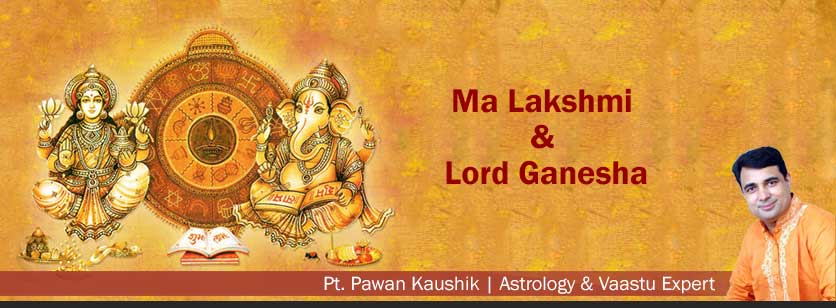
Lord Ganesha holds a very important place in the Hindu Mythology. Worshipping Ganesha, the elder son of Lord Shiva, not only leads to gain of knowledge; but also removes obstacles from life. Lord Ganesha, for this very reason, is also known as Vinayaka (most knowledgeable) and Vighnaharta (the one who removes obstacles from life). Before commencing any auspicious work or puja, the tradition of first seeking the blessings of Lord Ganesha can be noticed. Ganesha always carries a rope in one hand (which symbolizes his protections towards the devotee, an axe to remove all the obstacles, modak (a sweet dish) as a reward for His devotees, and the fourth hand is always depicted in the mudra for offering blessings. His elephant-like head and an expeditious mouse symbolizes enormous intelligence, sagacity and presence of mind.
THE MYTHOLOGICAL STORY:
According to Shiva Purana, while Goddess Parvati was going for a bath, She created a boy out of the turmeric paste from Her body and allotted him the responsibility to guard the entrance of her bathroom. She declared Him to be Her own son. As Lord Shiva arrived, Ganesha restricted Him to enter the bathroom. Outraged on His prevented access to Parvati’s room, He ordered His army to destroy Ganesha, but sadly, everybody failed. Surprised by the special powers & strength of this boy, Lord Shiva decided to fight Himself and struck off this boy’s head. Goddess Parvati broke down in grief after realizing what has happened and threatened to destroy the Universe. It is believed that Goddess Parvati only agreed to stop on two conditions:
- Lord Ganesha should be brought back to life
- He would be worshipped before any other God.
The helpless Lord Shiva had to send his gana (roop) to look for a replacement for this boy’s head. He asked His army to bring the head of the first creature they meet, facing North. While their hunt for a head, His army found a baby elephant sleeping, facing North. They brought the head of this elephant and Lord Shiva brought back life into this boy by attaching the head to his body. As agreed, Lord Shiva also gave him a boon that all Hindu devotees will worship Him before commencing any auspicious event. Lord shiva named him GANAPATI (gana = troop, pati = leader).
LORD GANESHA AND GODDESS LAXMI
Legends has it that Goddess Laxmi, the wife of Lord Vishnu, is considered as the most worshipped Goddess. Her self-obsession reached a point where one day, She began to proudly admire Herself in front of Lord Vishnu. Aggravated, Lord Vishnu thought it was important to kill Her immense ego and hence, told Her that She can enjoy all the powers but would never be able to feel the joy of motherhood, which is considered the most blissful feeling for a woman. On hearing this, Goddess Laxmi went to Her friend Goddess Parvati (mother of Ganesha and Kartikey). She narrated Her the incident and requested if She could adopt any of Her sons. Filled with pity, Goddess Parvati agreed to give away Ganesha. Goddess Laxmi vowed that devotees would have to worship Lord Ganesha along with Her hereafter to enjoy any blessings from Her. Due to this reason, any Laxmi pujan or Deepawali puja commences first by worshipping Lord Ganesha.
HOW TO OFFER PUJA
Keep in mind some special ingredients for the pujan of Goddess Laxmi and Lord Ganesha
- Unused idols of Goddess Laxmi and Lord Ganesha
- Red cloth for placing the idols,
- Kalash, coconut water and flowers
- Fresh garlands (3), Tulsi leaves, sweet paan, duba grass
- Silver coin, raw milk and Ganga jal
- Kheel and tambul (made of sugar)
- Roli (red sindioor), moli (red thread) and perfume
- Silver plate, silver diya and incense sticks
Method
- Before commencing the puja, place the idols in a silver plate, and bathe them with milk. Drain out any milk with Ganga jal (Holy water).
- After purifying the idols, they must be placed on a significantly higher position, over a red cloth.
- It is important to know the placement of the idols. The idol of Goddess Laxmi should always be placed on the left of Lord Ganesha.
- Swastika sign is created on the Kalash with roli, and moli is tied along the mouth of it. Place a coconut, covering the mouth of Kalash.
- Vermillion is applied on the idols of the Goddess Laxmi and Lord Ganesha, followed by garland of fresh flowers along with sweets.
- The devotees offer their prayers (aarti) and worship Lord Ganesha and Goddess Laxmi whole-heartedly. They welcome and request them to reside in their houses. The sweets are distributed among the devotees as prashad.
 +91 9990176000
+91 9990176000 +91 9999097600
+91 9999097600
 CALENDAR 2024
CALENDAR 2024










